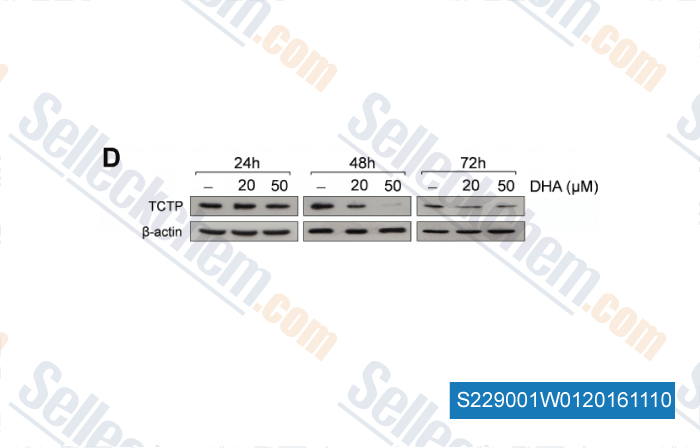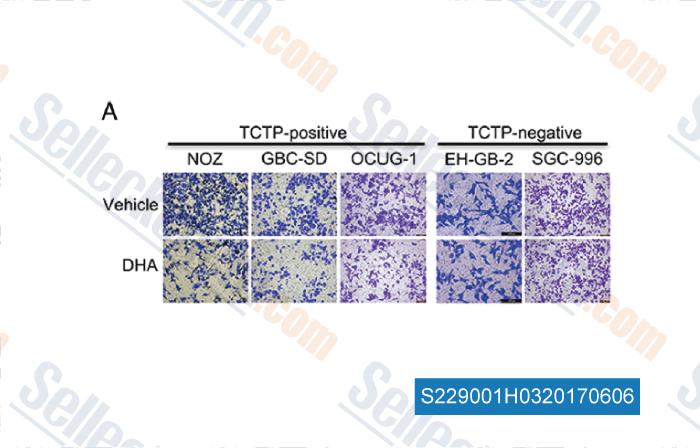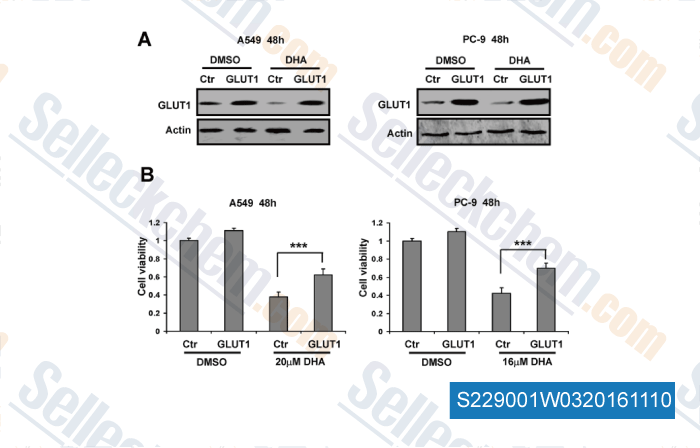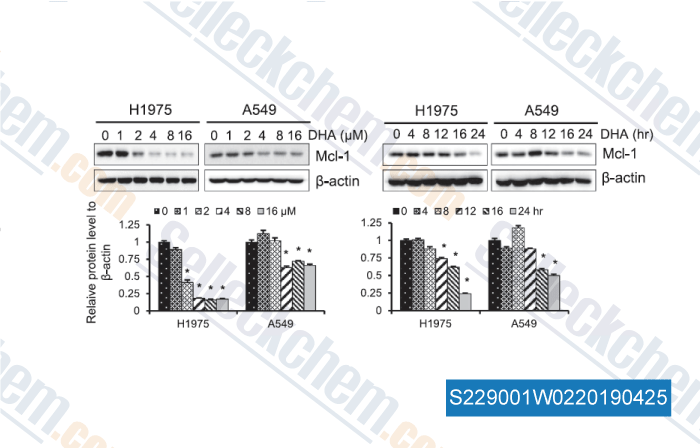|
Toll Free: (877) 796-6397 -- USA and Canada only -- |
Fax: +1-832-582-8590 Orders: +1-832-582-8158 |
Tech Support: +1-832-582-8158 Ext:3 Please provide your Order Number in the email. |
Technical Data
| Formula | C15H24O5 |
|||
| Molecular Weight | 284.35 | CAS No. | 71939-50-9 | |
| Solubility (25°C)* | In vitro | DMSO | 14 mg/mL (49.23 mM) | |
| Ethanol | 7 mg/mL (24.61 mM) | |||
| Water | Insoluble | |||
|
* <1 mg/ml means slightly soluble or insoluble. * Please note that Selleck tests the solubility of all compounds in-house, and the actual solubility may differ slightly from published values. This is normal and is due to slight batch-to-batch variations. * Room temperature shipping (Stability testing shows this product can be shipped without any cooling measures.) |
||||
Preparing Stock Solutions
Biological Activity
| Description | DHA (Dihydroartemisinin) is a semi-synthetic derivative of artemisinin and isolated from the traditional Chinese herb Artemisia annua. Dihydroartemisinin induces autophagy and apoptosis by suppressing NF-κB activation. | |
|---|---|---|
| Targets |
|
|
| In vitro | Dihydroartemisinin (DHA) inhibits the growth of certain cancer cell lines and xenograft tumors such as leukemia, glioma, fibrosarcoma, and breast, cervical, ovarian, lung, oral and pancreatic cancer. DHA inhibits cell and tumor growth by modulating various tumor-suppressive pathways, such as inhibiting cell proliferation and inducing apoptosis through regulation of proliferation- and apoptosis-related proteins.DHA inhibits the proliferation and viability of cells in a dose-dependent manner and induces apoptosis.DHA-mediated cytotoxicity is tumor selective. The endoperoxide bridge of DHA is reportedly essential for its cytotoxicity because it reacts with intracellular ferrous iron to generate reactive oxygen species or carbon-centered radicals, leading to cytotoxicity[1]. |
|
| In vivo | DHA significantly inhibited HCC cell growth in vitro and in vivo via inducing G2/M cell cycle arrest and apoptosis[2]. DHA has been shown in the rat whole embryo culture (WEC) to primarily affect primitive red blood cells (RBCs) causing subsequent tissue damage and dysmorphogenesis[3]. |
Protocol (from reference)
| Cell Assay: |
|
|---|---|
| Animal Study: |
|
References
Customer Product Validation

-
, , Oncotarget, 2015, 6(7):5275-91.

-
, , J Exp Clin Cancer Res, 2017, 36(1):68

-
, , PLoS One, 2015, 10(3):e0120426.

-
Data from [Data independently produced by , , Biochem Pharmacol, 2018, 150:72-85]
Selleck's DHA (Dihydroartemisinin) has been cited by 35 publications
| Dihydroartemisinin remodels tumor micro-environment and improves cancer immunotherapy through inhibiting cyclin-dependent kinases [ Int Immunopharmacol, 2024, 139:112637] | PubMed: 39033659 |
| Network-based prediction of anti-cancer drug combinations [ Front Pharmacol, 2024, 15:1418902] | PubMed: 39211773 |
| A pH Fingerprint Assay to Identify Inhibitors of Multiple Validated and Potential Antimalarial Drug Targets [ ACS Infect Dis, 2024, 10.1021/acsinfecdis.3c00588] | PubMed: 38499199 |
| Dihydroartemisinin, a potential PTGS1 inhibitor, potentiated cisplatin-induced cell death in non-small cell lung cancer through activating ROS-mediated multiple signaling pathways [ Neoplasia, 2024, 51:100991] | PubMed: 38507887 |
| Resistance to FOXM1 inhibitors in breast cancer is accompanied by impeding ferroptosis and apoptotic cell death [ Breast Cancer Res Treat, 2024, 10.1007/s10549-024-07420-9] | PubMed: 38980505 |
| Dihydroartemisinin ameliorates skeletal muscle atrophy in the lung cancer cachexia mouse model [ J Cancer Res Ther, 2024, 20(7):2004-2012] | PubMed: 39792410 |
| Protocol for analysis of intracellular conversion of artezomib molecules into new proteasome inhibitors in Plasmodium falciparum parasites [ STAR Protoc, 2024, 5(1):102896] | PubMed: 38363687 |
| Circulating extracellular vesicles are monitoring biomarkers of anti-PD1 response and enhancer of tumor progression and immunosuppression in metastatic melanoma [ J Exp Clin Cancer Res, 2023, 42(1):251] | PubMed: 37759291 |
| Micromolar Dihydroartemisinin Concentrations Elicit Lipoperoxidation in Plasmodium falciparum-Infected Erythrocytes [ Antioxidants (Basel), 2023, 12(7)1468] | PubMed: 37508006 |
| Dihydroartemisinin-induced ferroptosis in acute myeloid leukemia: links to iron metabolism and metallothionein [ Cell Death Discov, 2023, 9(1):97] | PubMed: 36928207 |
RETURN POLICY
Selleck Chemical’s Unconditional Return Policy ensures a smooth online shopping experience for our customers. If you are in any way unsatisfied with your purchase, you may return any item(s) within 7 days of receiving it. In the event of product quality issues, either protocol related or product related problems, you may return any item(s) within 365 days from the original purchase date. Please follow the instructions below when returning products.
SHIPPING AND STORAGE
Selleck products are transported at room temperature. If you receive the product at room temperature, please rest assured, the Selleck Quality Inspection Department has conducted experiments to verify that the normal temperature placement of one month will not affect the biological activity of powder products. After collecting, please store the product according to the requirements described in the datasheet. Most Selleck products are stable under the recommended conditions.
NOT FOR HUMAN, VETERINARY DIAGNOSTIC OR THERAPEUTIC USE.
